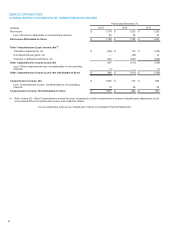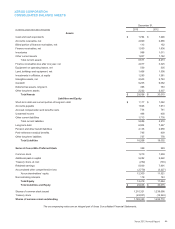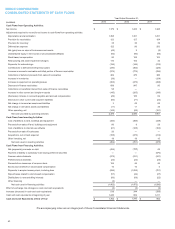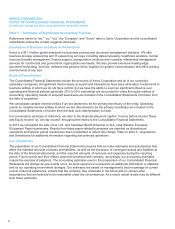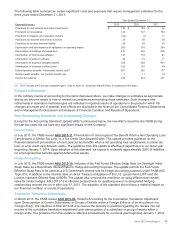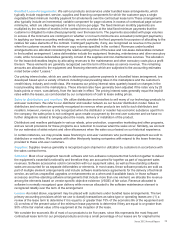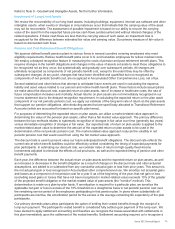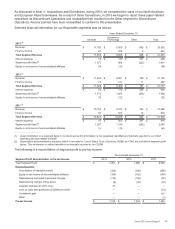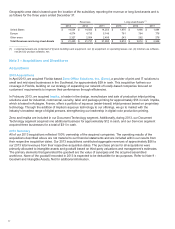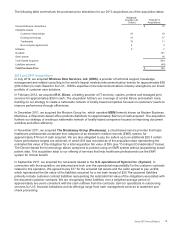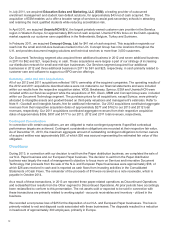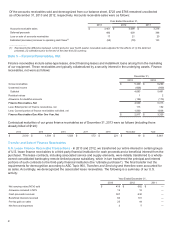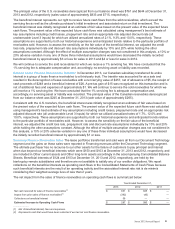Xerox 2013 Annual Report Download - page 89
Download and view the complete annual report
Please find page 89 of the 2013 Xerox annual report below. You can navigate through the pages in the report by either clicking on the pages listed below, or by using the keyword search tool below to find specific information within the annual report.Other Revenue Recognition Policies
Multiple Element Arrangements: As described above, we enter into the following revenue arrangements that may
consist of multiple deliverables:
• Bundled lease arrangements, which typically include both lease deliverables and non-lease deliverables as
described above.
• Contracts for multiple types of outsourcing services, as well as professional and value-added services. For
instance, we may contract for an implementation or development project and also provide services to operate
the system over a period of time; or we may contract to scan, manage and store customer documents.
In substantially all of our multiple element arrangements, we are able to separate the deliverables since we
normally will meet both of the following criteria:
• The delivered item(s) has value to the customer on a stand-alone basis; and
• If the arrangement includes a general right of return relative to the delivered item(s), delivery or performance of
the undelivered item(s) is considered probable and substantially in our control.
Consideration in a multiple-element arrangement is allocated at the inception of the arrangement to all deliverables
on the basis of the relative selling price. When applying the relative selling price method, the selling price for each
deliverable is primarily determined based on VSOE or third-party evidence (TPE) of the selling price. The above
noted revenue policies are then applied to each separated deliverable, as applicable.
Revenue-based taxes: We report revenue net of any revenue-based taxes assessed by governmental authorities
that are imposed on and concurrent with specific revenue-producing transactions. The primary revenue-based taxes
are sales tax and value-added tax (VAT).
Other Significant Accounting Policies
Shipping and Handling
Costs related to shipping and handling are recognized as incurred and included in Cost of sales in the Consolidated
Statements of Income.
Research, Development and Engineering (RD&E)
Research, development and engineering costs are expensed as incurred. Sustaining engineering costs are incurred
with respect to on-going product improvements or environmental compliance after initial product launch. Sustaining
engineering costs were $122, $110 and $108 in 2013, 2012 and 2011, respectively.
Cash and Cash Equivalents
Cash and cash equivalents consist of cash on hand, including money market funds, and investments with original
maturities of three months or less.
Receivable Sales
We regularly transfer certain portions of our receivable portfolios and normally account for those transfers as sales
based on meeting the criteria for derecognition in accordance with ASC Topic 860 "Transfer and Servicing" of
Financial Assets. Gains or losses on the sale of receivables depend, in part, on both (a) the cash proceeds and (b)
the net non-cash proceeds received or paid. When we sell receivables we normally receive beneficial interests in
the transferred receivables from the purchasers as part of the proceeds. We may refer to these beneficial interests
as a deferred purchase price. The beneficial interests obtained are initially measured at their fair value. We
generally estimate fair value based on the present value of expected future cash flows, which are calculated using
management's best estimates of the key assumptions including credit losses, prepayment rate and discount rates
commensurate with the risks involved. Refer to Note 4 - Accounts Receivable, Net and Note 5 - Finance
Receivables, Net for more details on our receivable sales.
Inventories
Inventories are carried at the lower of average cost or market. Inventories also include equipment that is returned at
the end of the lease term. Returned equipment is recorded at the lower of remaining net book value or salvage
value, which normally are not significant. We regularly review inventory quantities and record a provision for excess
and/or obsolete inventory based primarily on our estimated forecast of product demand, production requirements
and servicing commitments. Several factors may influence the realizability of our inventories, including our decision
to exit a product line, technological changes and new product development. The provision for excess and/or
Xerox 2013 Annual Report 72



